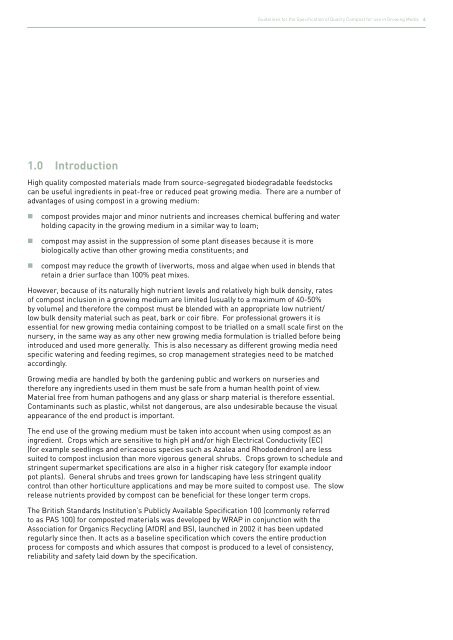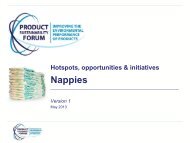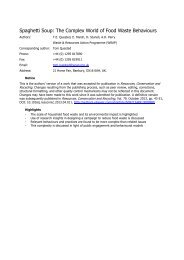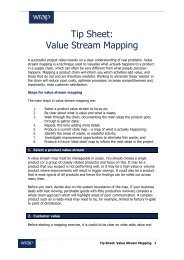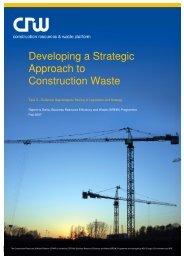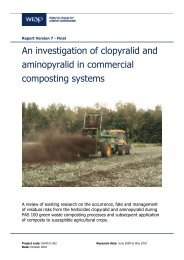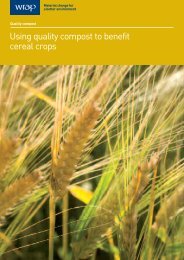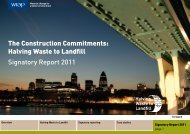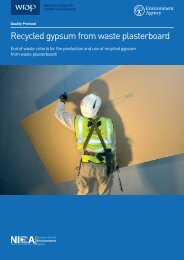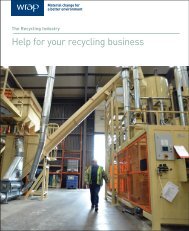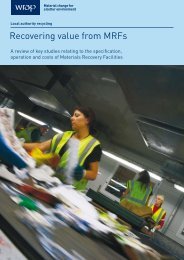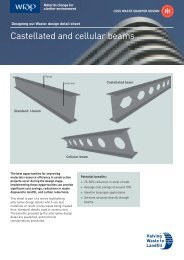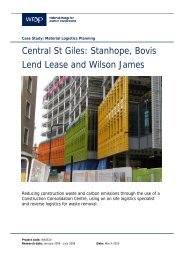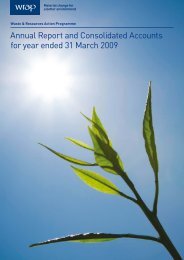Guidelines for the Specification of Quality Compost for use in ... - Wrap
Guidelines for the Specification of Quality Compost for use in ... - Wrap
Guidelines for the Specification of Quality Compost for use in ... - Wrap
Create successful ePaper yourself
Turn your PDF publications into a flip-book with our unique Google optimized e-Paper software.
<strong>Guidel<strong>in</strong>es</strong> <strong>for</strong> <strong>the</strong> <strong>Specification</strong> <strong>of</strong> <strong>Quality</strong> <strong>Compost</strong> <strong>for</strong> <strong>use</strong> <strong>in</strong> Grow<strong>in</strong>g Media 4<br />
1.0 Introduction<br />
High quality composted materials made from source-segregated biodegradable feedstocks<br />
can be <strong>use</strong>ful <strong>in</strong>gredients <strong>in</strong> peat-free or reduced peat grow<strong>in</strong>g media. There are a number <strong>of</strong><br />
advantages <strong>of</strong> us<strong>in</strong>g compost <strong>in</strong> a grow<strong>in</strong>g medium:<br />
• compost provides major and m<strong>in</strong>or nutrients and <strong>in</strong>creases chemical buffer<strong>in</strong>g and water<br />
hold<strong>in</strong>g capacity <strong>in</strong> <strong>the</strong> grow<strong>in</strong>g medium <strong>in</strong> a similar way to loam;<br />
• compost may assist <strong>in</strong> <strong>the</strong> suppression <strong>of</strong> some plant diseases beca<strong>use</strong> it is more<br />
biologically active than o<strong>the</strong>r grow<strong>in</strong>g media constituents; and<br />
• compost may reduce <strong>the</strong> growth <strong>of</strong> liverworts, moss and algae when <strong>use</strong>d <strong>in</strong> blends that<br />
reta<strong>in</strong> a drier surface than 100% peat mixes.<br />
However, beca<strong>use</strong> <strong>of</strong> its naturally high nutrient levels and relatively high bulk density, rates<br />
<strong>of</strong> compost <strong>in</strong>clusion <strong>in</strong> a grow<strong>in</strong>g medium are limited (usually to a maximum <strong>of</strong> 40-50%<br />
by volume) and <strong>the</strong>re<strong>for</strong>e <strong>the</strong> compost must be blended with an appropriate low nutrient/<br />
low bulk density material such as peat, bark or coir fibre. For pr<strong>of</strong>essional growers it is<br />
essential <strong>for</strong> new grow<strong>in</strong>g media conta<strong>in</strong><strong>in</strong>g compost to be trialled on a small scale first on <strong>the</strong><br />
nursery, <strong>in</strong> <strong>the</strong> same way as any o<strong>the</strong>r new grow<strong>in</strong>g media <strong>for</strong>mulation is trialled be<strong>for</strong>e be<strong>in</strong>g<br />
<strong>in</strong>troduced and <strong>use</strong>d more generally. This is also necessary as different grow<strong>in</strong>g media need<br />
specific water<strong>in</strong>g and feed<strong>in</strong>g regimes, so crop management strategies need to be matched<br />
accord<strong>in</strong>gly.<br />
Grow<strong>in</strong>g media are handled by both <strong>the</strong> garden<strong>in</strong>g public and workers on nurseries and<br />
<strong>the</strong>re<strong>for</strong>e any <strong>in</strong>gredients <strong>use</strong>d <strong>in</strong> <strong>the</strong>m must be safe from a human health po<strong>in</strong>t <strong>of</strong> view.<br />
Material free from human pathogens and any glass or sharp material is <strong>the</strong>re<strong>for</strong>e essential.<br />
Contam<strong>in</strong>ants such as plastic, whilst not dangerous, are also undesirable beca<strong>use</strong> <strong>the</strong> visual<br />
appearance <strong>of</strong> <strong>the</strong> end product is important.<br />
The end <strong>use</strong> <strong>of</strong> <strong>the</strong> grow<strong>in</strong>g medium must be taken <strong>in</strong>to account when us<strong>in</strong>g compost as an<br />
<strong>in</strong>gredient. Crops which are sensitive to high pH and/or high Electrical Conductivity (EC)<br />
(<strong>for</strong> example seedl<strong>in</strong>gs and ericaceous species such as Azalea and Rhododendron) are less<br />
suited to compost <strong>in</strong>clusion than more vigorous general shrubs. Crops grown to schedule and<br />
str<strong>in</strong>gent supermarket specifications are also <strong>in</strong> a higher risk category (<strong>for</strong> example <strong>in</strong>door<br />
pot plants). General shrubs and trees grown <strong>for</strong> landscap<strong>in</strong>g have less str<strong>in</strong>gent quality<br />
control than o<strong>the</strong>r horticulture applications and may be more suited to compost <strong>use</strong>. The slow<br />
release nutrients provided by compost can be beneficial <strong>for</strong> <strong>the</strong>se longer term crops.<br />
The British Standards Institution’s Publicly Available <strong>Specification</strong> 100 (commonly referred<br />
to as PAS 100) <strong>for</strong> composted materials was developed by WRAP <strong>in</strong> conjunction with <strong>the</strong><br />
Association <strong>for</strong> Organics Recycl<strong>in</strong>g (AfOR) and BSI, launched <strong>in</strong> 2002 it has been updated<br />
regularly s<strong>in</strong>ce <strong>the</strong>n. It acts as a basel<strong>in</strong>e specification which covers <strong>the</strong> entire production<br />
process <strong>for</strong> composts and which assures that compost is produced to a level <strong>of</strong> consistency,<br />
reliability and safety laid down by <strong>the</strong> specification.


